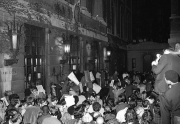From A Neighborhood in Transition
You have reached the page on History and Politics in Morningside Heights, New York. The history of the neighborhood has contributed to its status now as an important part of New York City, and current controversy over Columbia's expansion remains a highly contested political issue in the area. Below we will analyze in detail the rich history and political makeup of the neighborhood to determine how these elements contribute to the cultural identity of the area.
Contents |
History
For the main article, see History.
From the late 1700's, when Morningside Heights was nothing more than tranquil wheat fields to its present status as an educational oasis and desirable commercial and residential area, Morningside Heights is a neighborhood rich with history. As a neighborhood with multiple institutions of higher education, Morningside Heights has long held a reputation for intellect and advanced learning in New York City. However, the history of the neighborhood encompasses much more than that. As the site for battles, protests, and ongoing controversial use of land, Morningside Heights maintains its vibrant past as a historical stronghold in New York City.
Politics
For the main article, see Politics.
Morningside Heights is a part of the 15th Congressional District, which is currently represented by Congressman Charles B. Rangel. The 15th Congressional District also includes Harlem, Inwood, Marble Hill, Spanish Harlem, Washington Heights, and parts of the Upper West Side. Traditionally, the area of Morningside Heights has been heavily democratic, from its City Council Members to its Congresspersons. The community of Morningside Heights and surrounding areas has been dealing with the gentrification of its neighborhood, largely due in part to Columbia University's plans to expand its campus, which is already a dominant feature of the area. This issue will be further explored in an analysis of the political issues in the neighborhood.
Go back to Main Page


